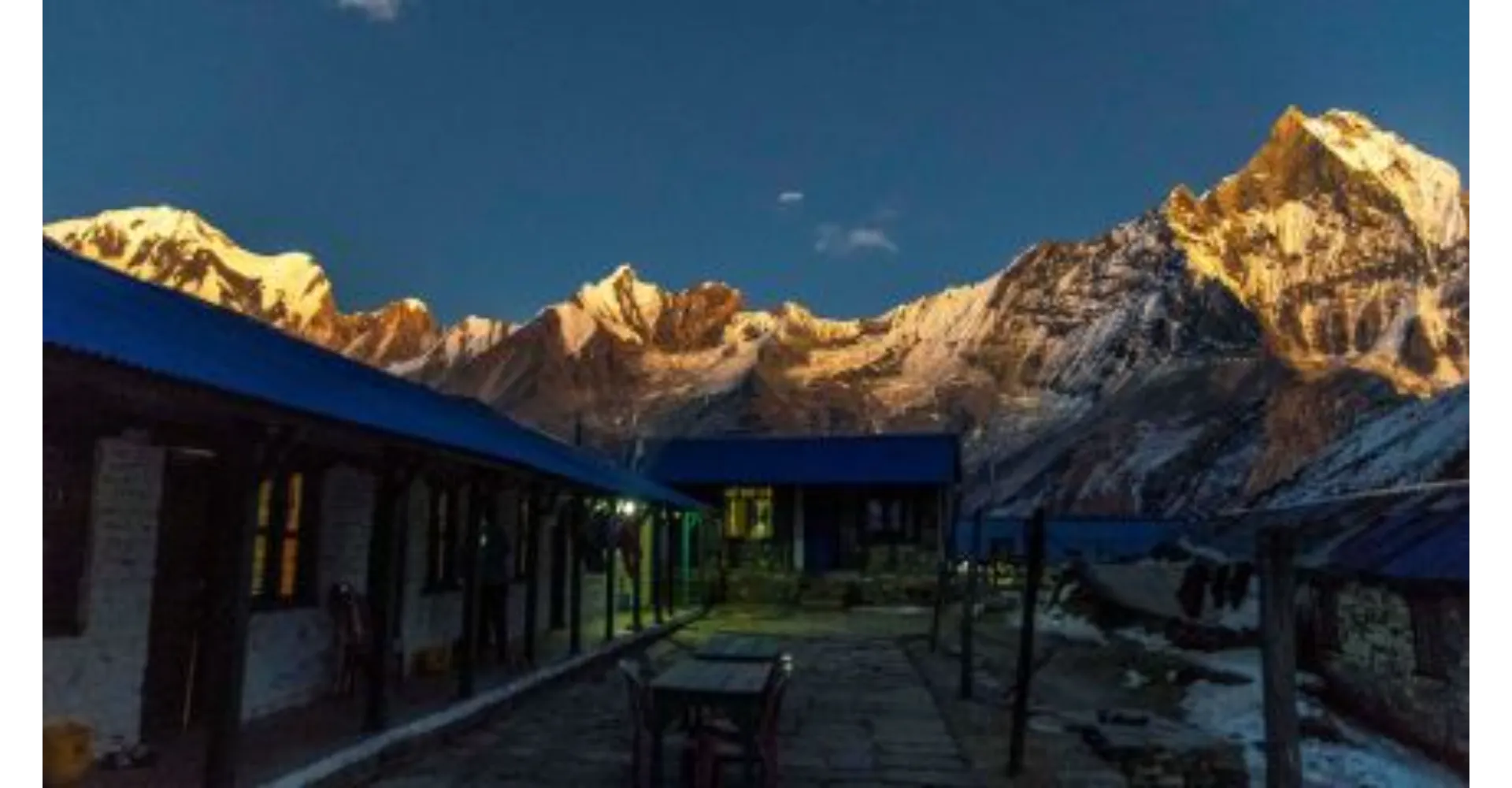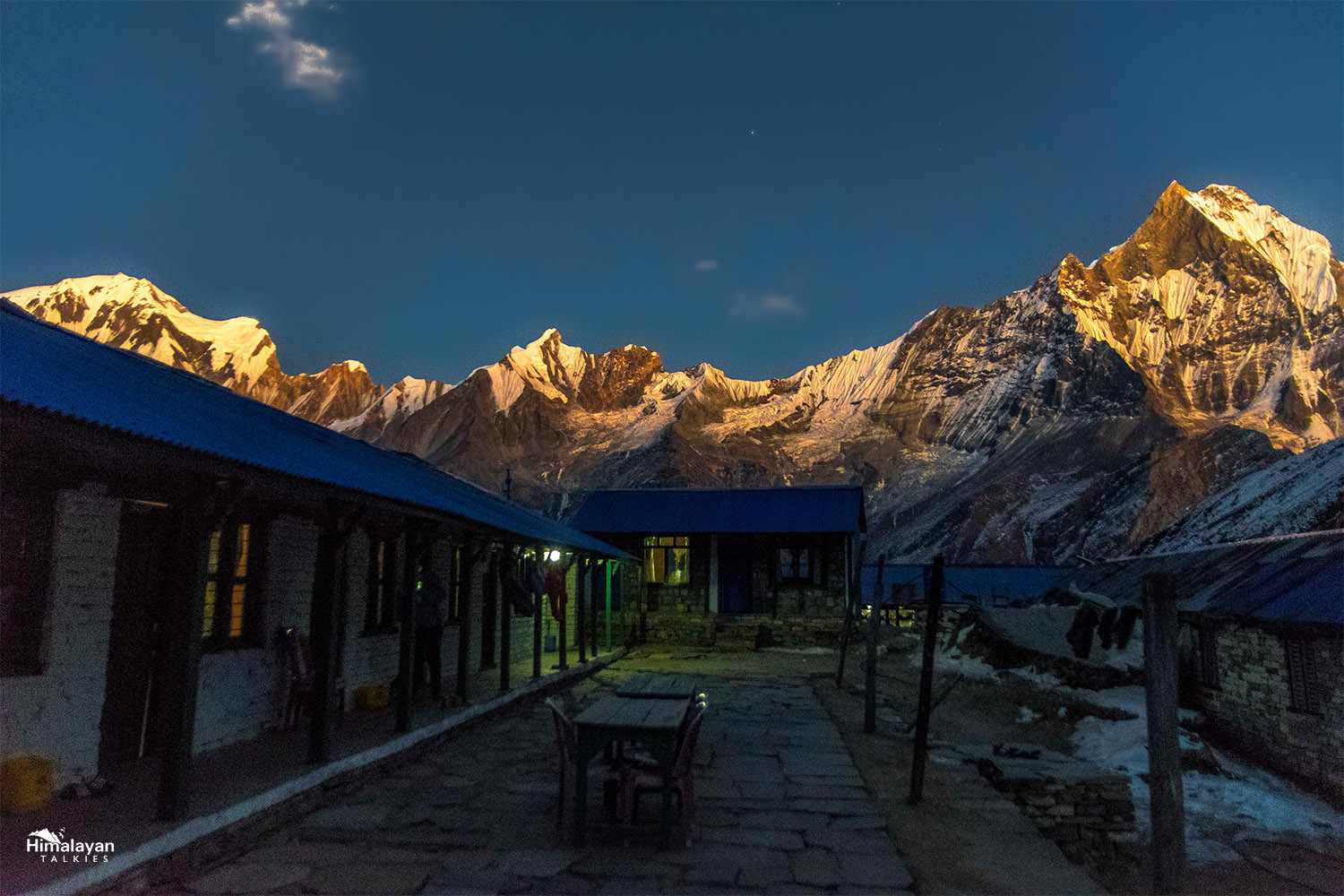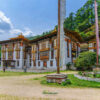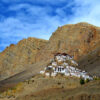6-7 Days Itinerary of Annapurna Base Camp
Annapurna Base Camp (as the name sounds) is the base camp to climb one of the highest peaks in the world or rather I should put it as one of the most elegant and challenging, 8000er, the 10th highest peak in the world Annapurna (8091m). People all across the world take this trail to witness the magnificent Annapurna Massif from the base camp.
One of the most rewarding treks that one can take, where along with ABC you get to cover another base camp. Yes, that is right, the base camp to one of the most beautiful peaks in the world, Machapuchare/ Machhapuchhare (6993Mts) (also known as the Fishtail).
From exploring Pokhara (one of the most charming towns of Nepal) to walking in the Annapurna Conversation area through the rhododendrons and dense forest area, staying in the most scenic Tea houses, soaking in the warmth of Nepali hospitality, and finally leaving the tree line behind to walk in the barren lands covered with high Himalayan Mountain peaks all around you, is all that you can expect from this trek. If that is not enough, it is reasonably challenging too. People struggling to lose weight can easily lose 6-8kgs after you are back. (at least happened with me).
After all, one thing is given, that this journey will be one of the most memorable journeys of your lifetime. Although a bit less testing as compared to many other trekking trails in Nepal, the base camp of Annapurna offers a better view than EBC (which is one of the most opted treks besides ABC). (Totally my opinion and I am talking of the view of the base camp alone)
Not1, not 2, this trail offers the view of several Himalayan peaks right in front of you. The peaks visible are the Annapurna Masiff (peaks like Annapurna 1, Annapurna 2, Annapurna South), Hiunchuli, Gangapurna, Gandharbachuli & Machhapuchhare. The view during Sunset and sunrise from the base camp is unparalleled.
While on this trail, even if you don’t go by a stipulated itinerary, almost every 2-3 hours you will cross a village where you will find ample tea houses on the way (if not travelling in peak season). Still, out of my experience, I thought to share the most common itinerary to do this trek as it may help you plan it. There are many routes to reach Annapurna base camp, however, people prefer taking different routes while going and coming to be able to witness diversity and make the journey less monotonous.
Trek Grade & Altitude
Maximum Altitude – 4130mt/13550ft
Trek Level – Moderate/Difficult
While I rate this trek as moderate-difficult, to put things in perspective what makes this trek demanding is that you have to descend and ascend almost twice every day with many staircase stretches which takes too much toll on your knees and calves. Hence being in decent physical shape (if not excellent) is advisable. Especially you should work on your legs and stamina before taking on this stretch to mitigate the adversities.

Best Time to Visit
ABC is a trek that can be done during any month & season of the year and the experience will be unique to every season. However, I will avoid Monsoons because it would obstruct the views and the trail would become slippery too
The best months as per the handbook are – Mar to Early May and then Oct to Mid Dec.
As far as my experience goes, if you can bear the cold, it is best done in Jan-Feb for 3 precise reasons 1) It isn’t much crowed 2) You get the sharpest of views because of no haze and 3) In case it snows, you get to experience the snow trek too. The only downside however is if it snows too much and the route gets closed, it might be disappointing.
The shorter Itinerary
7 Nights 8 Days
Day 0 – Arrive in Pokhara. Altitude 1400m/4600ft
Pokhara is a quaint town with a beautiful lake and a view of mesmerizing Himalayan peaks on a clear day. Explore cafes, Peace Pagoda, Lake, Sarangkot, etc. You can also indulge in adventure sports like Paragliding at Sarangkot.
Day 1 – Pokhara to Ghadruk.
Drive to Nayapul (40Km; 1:30 Hrs) & Then Trek to Ghandruk (5Km; 5-6 hrs).
Altitude: 2000m/6500ft
It is a very scenic drive till Nayapul and then from Nayapul you enter into the Annapurna Conservation Area. You may even find conveyance at Nayapul (a shared jeep or a bus) till almost a few km short of Ghandruk to Syuali Bazar/Siwai which you can do to save time. The ascend is either gradual alongside Modi Khola (Modi river) with some steep staircase stretches. The last 2 kms are perhaps a bit strenuous. Ghandruk is a beautiful village with comfortable and cozy Tea Houses to stay.
Peaks Visible – Annapurna South, Hiunchuli & Machapuchare
Day 2 – Ghandruk to Chhomrong/Sinuwa
Trek 10-12Kms; 6-8 Hrs
Altitude: 2200m/7200ft – 2320m/7600ft
This can be called our first day when we get serious with trekking. As you cross the village, initially you walk on a gradual ascend for some time, and then there is a steep ascend till upper Kimrong. Post which you descend sharply until the river bed of Kimrong Khola from where again take a very steep ascend till Chhomrong through the forest and dense tree line.
Chhomrong is a vast settlement with several tea houses, cafes, and houses. This is the place where you can get most of the essentials in case you have forgotten anything
Peaks Visible – Annapurna South, Gangapurna, Fishtail, Hiunchuli


Day 3 – Chhomrong/Sinuwa to Himalaya/Deurali
Trek 12-14 Kms 7-9 Hrs
Altitude: 2920m/9600ft – 3100m/10200ft
Again a challenging day, where you first start descending to the river bed of Chhomrong Khola, and then there is a sharp ascend towards Sinuwa and staircase is enough to make you fall short of breath. Post that it is a gradual ascend till Bamboo and Dovan with a couple of steep descends and ascends. However, after Dovan it is a steep climb till Himalaya. If you plan to move forward to Deurali, it is again an ascend.
Peaks Visible – Annapurna III & Fishtail Peaks
Day 4 – Himalaya/Deuarali to ABC Via MBC
Trek 7-9 Kms 7-8 Hrs
Altitude: 4130m/13500ft
First, you ascend towards Deurali post and as we leave the tree line behind, we are in the low oxygen zone. Climbing up to the MBC makes you gasp for breath as it is a steep ascend. Once at MBC, from there on, the walk towards ABC although tough because of High Altitude but isn’t very strenuous as it is a gradual ascend. Annapurna Base Camp offers you a 360-degree view of the Himalayan ranges with a couple of Lodges to stay in which keep you warm to survive the harsh cold.
Peaks Visible – Entire Annapurna range including Annapurna South, Annapurna I, II & III, Hiunchuli, Gandharbachuli, Gangapurna & Machapuchare


Day 5 – ABC to Bamboo
Trek 14Kms; 5-6 Hrs
Altitude: 2350m/7700ft
As we start descending today with a sharp decline in altitude, you would feel really good and shall be able to keep up a brilliant pace. We come back the same route and halt at Bamboo.


Day 6 – Bamboo – Jhinu Hot Springs
Trek 12Kms; 5 Hrs
Altitude: 1610m/5300ft
We take the same route back till Chhorong via Sinuwa and then we take a route which sharply descends to Jhinu Danda and Jhinu hot springs. You can take a dip in the hot springs.
Day 7 – Jhinu to Pokhara
Trek 10-11 Kms; 6-7 Hrs Drive 40Kms; 1:30 Hrs
Altitude 1400m/4600ft
This is the last day of our trek. We walk towards Syauli Bazaar and then towards Nayapul. However, as stated earlier you can get a conveyance from Siwai/ Syauli Bazar itself which will reduce the trek. There is another route as well which you can take for Pokhara via Landruk, Dhampus, and Phedi.

Departure
This day you depart from Pokhara towards Kathmandu.
The itinerary mentioned above can be further tweaked. You can add 1-2 nights and relax it a bit. A night at MBC is highly recommended. Similarly, you can even reduce a day if you walk fast. While descending we can reach Pokhara in 2 days instead of 3. Even if you change your plan on the go, you shouldn’t face much problem finding stays (until it is peak season, and the stays are pre-booked).
You may even extend your stay a Pokhara and Kathmandu to explore more.
Furthermore, to make the itinerary more diverse, there is a detailed trek, that travelers prefer which is through Poonhill & Ghorepani. Will do another article for the same.
How to Reach Pokhara
For all countries
Fly to Kathmandu
Then you can reach Pokhara by one of the following
By Air – A domestic flight from Kathmandu to Pokhara would take around 30 Mins
By road – You can also reach Pokhara by road for which you can hire a taxi or board a bus. It would take you around 6-7 hours
From India – one can even reach Pokhara by road via Gorakhpur and then Sonauli
Confused about joining a group or doing it Solo? With a guide or without? Here’s all that you need to know
A guide is not mandatory for this trek. However, you may choose to pick one in case you need it.
Nepal is a trek-friendly country, and it is very convenient to do these treks in Nepal.
You can plan to travel as you deem fit.
Join a big group, where you join a group of 8-14 people and they will have a proper guide. You can add a porter if you require
Engage a local operator to join a small group which may be between 2-5 people where you will get one guide. You can add a porter if you require
If you are solo and still plan to not do it alone, you don’t need to worry, you can get in touch with any company, you can get a guide for you alone. However, as the guides are costly, the best bet for you is to hire a porter cum guide who speaks decent English and can help you carry some load of yours too and is pocket friendly too
If you want to do it solo, just don’t worry. Pick up your bag, prepare and go. The trail is well marked, and you won’t face any problems
Just to categorize the kind of help you can get
Guide – A proper English-speaking guide. You may also engage guides speaking other languages. They will be the costliest and won’t carry any luggage
Porter – A guy who will only pick up your luggage up to 20kgs and charge for it. If he can converse with you and tell you about the place, that’s a bonus. This category charges the least
Porter Cum Guide – A person who can speak/understand decent English and can carry luggage up to 10-12kgs. He will charge somewhere between the other 2 categories. Apt for people who are solo needing some help and don’t want to join a big group.
What to Carry
- Permit for ABC trekking (needs to obtain from Tourist Police Office and Permit Office) If you are doing it with a tour operator, they will get it arranged for you. You can even ask your hotel/homestay owner to help you with this. They may charge a little extra for this
- TIMS (Trekkers’ Information Management System) card (to be obtained from Tourist Police Office or Permit Office near Lake Side Pokhara). If you are doing it with a tour operator, they will get it arranged for you. You can even ask your hotel/homestay owner to help you with this. They may charge a little extra for this
- 4 Passport size photos (Tourist Office at Pokhara even has a free photo booth for TIMS and permit)
- A good backpack (45L-60L would do)
- A good pair of Trekking shoes (should be waterproof if you plan to do the trek in monsoons) with spare pair of laces
- Down Jacket
- Thermal wear
- Lightweight rain Coat/Poncho
- Sleeping bags (You will get blankets and quilts in the tea houses/lodges but it is still advisable to carry your sleeping bag). You can even get Sleeping bags on rent from Kathmandu/Pokhara
- Slippers (for indoor & toilet use)
- Woolen gloves
- T-shirts 4-5 ( It gets sweaty if it is a clear sky)
- Trekking pants 2-3
- Underwear (5-6)
- Trekking socks (4-5 pairs) and Woolen socks (2 Pairs)
- Trekking Poles (you may also rent it from Pokhara/Kathmandu). However, you get good quality trekking poles at superb prices.
- Woolen Cap/Skull Cap/ balaclava
- Sunglasses
- Lightweight towel
- Diamox tablets (for altitude sickness), Other Normal medicines & any specific medications that you take.
- Hiking lights (to walk in the dark)
- Toilet papers, Napkins, Wet tissues, and other sanitary items
- Passport & Visa ( Not required for Indians) but if going by flight you should carry your passport.
- First aid kit
- Power bank ( some places charge amount for electronic items charging)
- Most important of all carry ENOUGH MONEY!!! (The last ATM is at Pokhara). You should even get currency exchanged from your trip operator or at a local shop in Kathmandu/Pokhara. For Indians, they may even accept Indian currency but it is still advisable to carry Nepali currency.
- Cameras/Action Cams/Gimble
- Charging Cables
- Cosmetics especially Sunscreen, Cold Creem, Lip Balms, etc



